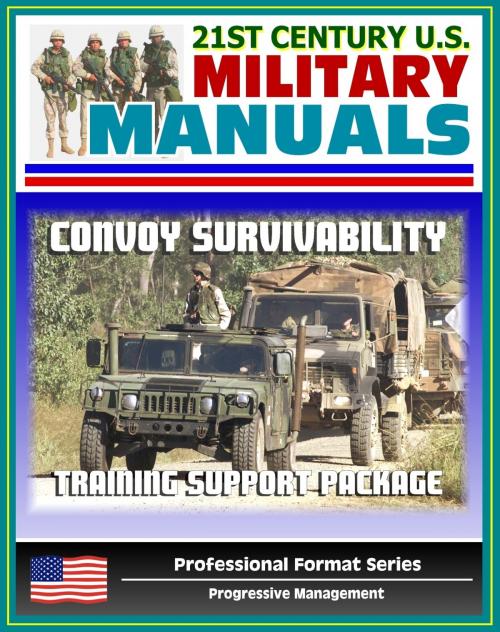21st Century U.S. Military Manuals: Convoy Survivability Training Support Package - Defense Against Improvised Explosive Devices (IED) and Roadside Bombs (Professional Format Series)
Nonfiction, Science & Nature, Technology, Military Science, Social & Cultural Studies, Political Science| Author: | Progressive Management | ISBN: | 9781458131379 |
| Publisher: | Progressive Management | Publication: | May 26, 2011 |
| Imprint: | Smashwords Edition | Language: | English |
| Author: | Progressive Management |
| ISBN: | 9781458131379 |
| Publisher: | Progressive Management |
| Publication: | May 26, 2011 |
| Imprint: | Smashwords Edition |
| Language: | English |
Professionally converted for accurate e-book format reproduction, this important U.S. Army Training Support Package document presents information on enemy tactics, techniques, and procedures for attacking convoys in Iraq (and now Afghanistan), as well as U.S. measures in effect to counter them. Specific areas of instruction include but are not limited to hardening vehicles, defending against attack, consolidation and reorganization, gun truck employment, various reports, battle drills, and basic instructions for setting up a convoy live fire exercise. The document states in part: "During this course of instruction you will learn to: Identify the threat; harden vehicles; conduct convoy briefing; execute motor movement; defend against attack; defend against Improvised Explosive Devices (IED); conduct convoy consolidation and reorganization; conduct actions at the Release Point (RP); describe the purpose and functions of the gun truck; identify gun truck crew duties; harden gun trucks; employ gun trucks; identify emerging enemy trends on the battlefield. The arrival of the Twenty-first Century brought with it a different way of doing business on the battlefield. This style of warfare, known as the Contemporary Operational Environment, or COE, will be the mode in which the United States Army fights for many years to come. COE is an asymmetric environment, meaning that one side is well manned, well-organized, and well-equipped, while the other side consists of an irregular guerrilla force incapable of fighting a conventional battle with any hope of victory. Concepts covered include VBIEDs, PBIEDs, gun trucks, armor and hardening, ambush defense, EFPs, kidnapping, gunnery tables, obstacle avoidance, MEDEVAC, box formation, convoy task organization, and convoy defense doctrine.
The enemy weapon of choice is the improvised explosive device (IED), which is usually placed on or near the shoulder of a paved road most often within ten feet of the pavement. Most IED blasts come not from directly underneath the vehicle, but from the front at an oblique angle, or directly at the flank. Because of this, most efforts to armor vehicles in Iraq are oriented more heavily toward the doors and fenders than the floorboard. In other areas, such as Afghanistan, the predominant threat is land mines, which are buried on unimproved roads. IEDs are classified in three types: Static IEDs, Vehicle Borne IEDs (VBIED) and Person Borne IEDs (PBIED). Although the method of delivery differs between the classes, the three types of IED often share the same characteristics. The most common type is the static IED. IEDs can be command detonated, victim actuated, or timed. Although IEDs can be detonated using mechanical means, they are most commonly detonated using hardwired systems, radio controlled systems, or more recently, passive infra-red sensors. Car alarms, battery-powered remote doorbells, remote controlled light switches, key fobs, remote controlled toys, handheld radios, long range cordless telephones, garage door openers, and cell phones are common means of detonation. Any and all types of insulated wire can be used to connect the detonator to the explosive. IEDs in Theater usually incorporate military ordnance, but they can be devised using non-military components as well. IEDs may be fashioned from mortar shells, artillery projectiles, anti-tank mines, diesel fuel or mogas, rockets, black powder, fertilizer, chemical explosives, household cleaning products, etc. IEDs can be daisy chained. A daisy chain is two or more explosive devices wired together so that a single signal will detonate all the munitions at once. Daisy chained IEDs are not limited to one side of the road. They may be placed on both sides, and configured to detonate simultaneously
This is a privately authored news service and educational publication of Progressive Management.
Professionally converted for accurate e-book format reproduction, this important U.S. Army Training Support Package document presents information on enemy tactics, techniques, and procedures for attacking convoys in Iraq (and now Afghanistan), as well as U.S. measures in effect to counter them. Specific areas of instruction include but are not limited to hardening vehicles, defending against attack, consolidation and reorganization, gun truck employment, various reports, battle drills, and basic instructions for setting up a convoy live fire exercise. The document states in part: "During this course of instruction you will learn to: Identify the threat; harden vehicles; conduct convoy briefing; execute motor movement; defend against attack; defend against Improvised Explosive Devices (IED); conduct convoy consolidation and reorganization; conduct actions at the Release Point (RP); describe the purpose and functions of the gun truck; identify gun truck crew duties; harden gun trucks; employ gun trucks; identify emerging enemy trends on the battlefield. The arrival of the Twenty-first Century brought with it a different way of doing business on the battlefield. This style of warfare, known as the Contemporary Operational Environment, or COE, will be the mode in which the United States Army fights for many years to come. COE is an asymmetric environment, meaning that one side is well manned, well-organized, and well-equipped, while the other side consists of an irregular guerrilla force incapable of fighting a conventional battle with any hope of victory. Concepts covered include VBIEDs, PBIEDs, gun trucks, armor and hardening, ambush defense, EFPs, kidnapping, gunnery tables, obstacle avoidance, MEDEVAC, box formation, convoy task organization, and convoy defense doctrine.
The enemy weapon of choice is the improvised explosive device (IED), which is usually placed on or near the shoulder of a paved road most often within ten feet of the pavement. Most IED blasts come not from directly underneath the vehicle, but from the front at an oblique angle, or directly at the flank. Because of this, most efforts to armor vehicles in Iraq are oriented more heavily toward the doors and fenders than the floorboard. In other areas, such as Afghanistan, the predominant threat is land mines, which are buried on unimproved roads. IEDs are classified in three types: Static IEDs, Vehicle Borne IEDs (VBIED) and Person Borne IEDs (PBIED). Although the method of delivery differs between the classes, the three types of IED often share the same characteristics. The most common type is the static IED. IEDs can be command detonated, victim actuated, or timed. Although IEDs can be detonated using mechanical means, they are most commonly detonated using hardwired systems, radio controlled systems, or more recently, passive infra-red sensors. Car alarms, battery-powered remote doorbells, remote controlled light switches, key fobs, remote controlled toys, handheld radios, long range cordless telephones, garage door openers, and cell phones are common means of detonation. Any and all types of insulated wire can be used to connect the detonator to the explosive. IEDs in Theater usually incorporate military ordnance, but they can be devised using non-military components as well. IEDs may be fashioned from mortar shells, artillery projectiles, anti-tank mines, diesel fuel or mogas, rockets, black powder, fertilizer, chemical explosives, household cleaning products, etc. IEDs can be daisy chained. A daisy chain is two or more explosive devices wired together so that a single signal will detonate all the munitions at once. Daisy chained IEDs are not limited to one side of the road. They may be placed on both sides, and configured to detonate simultaneously
This is a privately authored news service and educational publication of Progressive Management.















